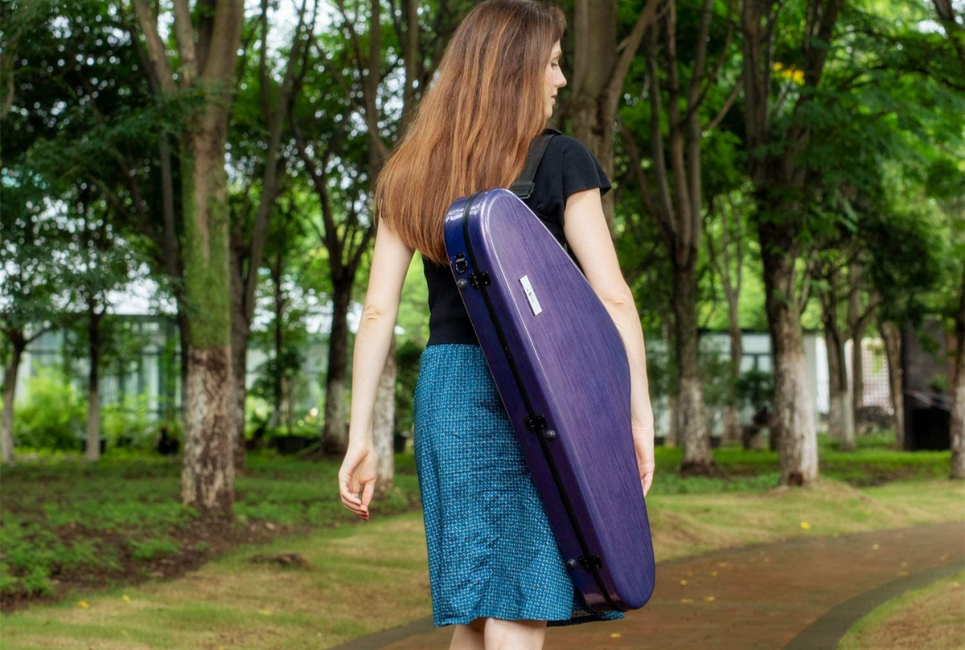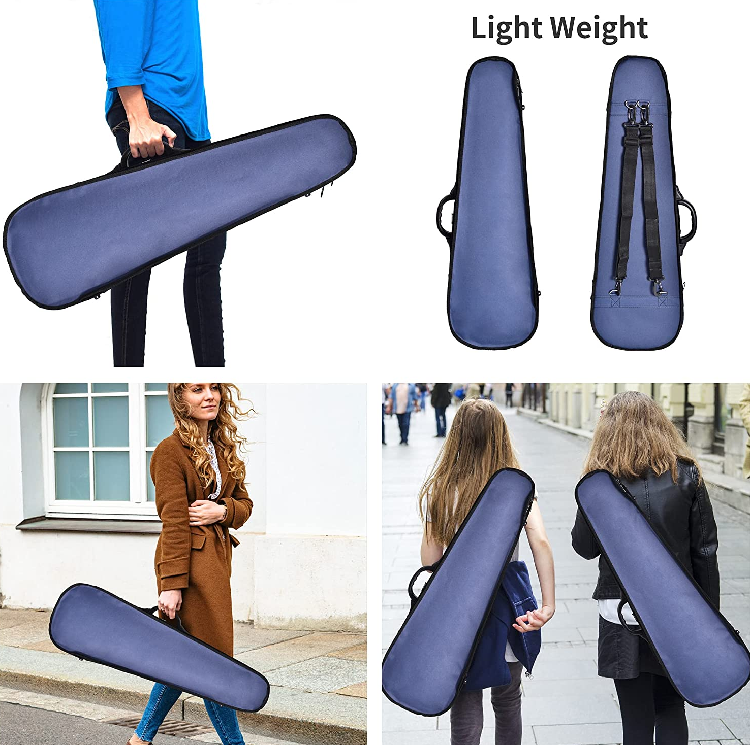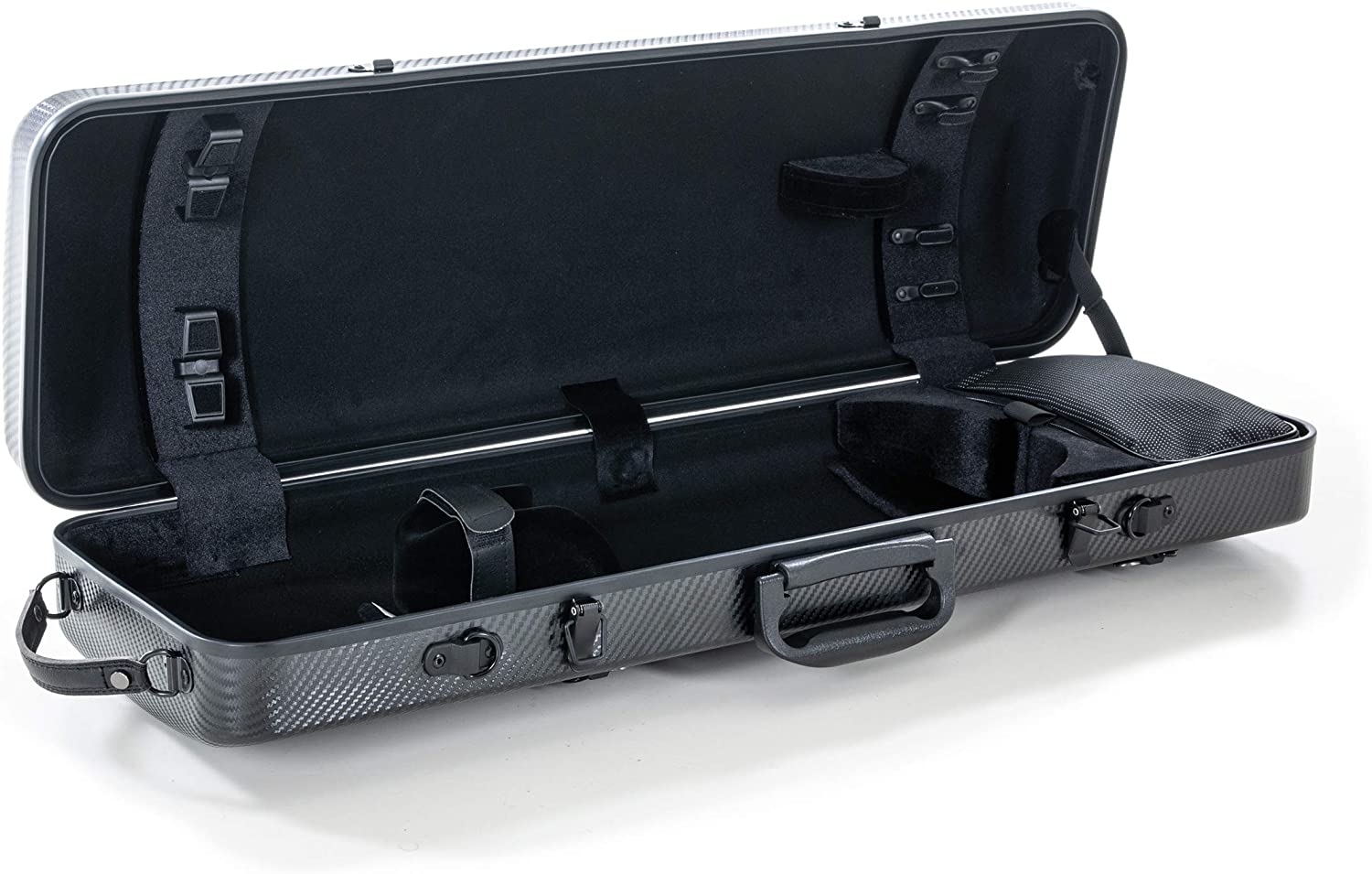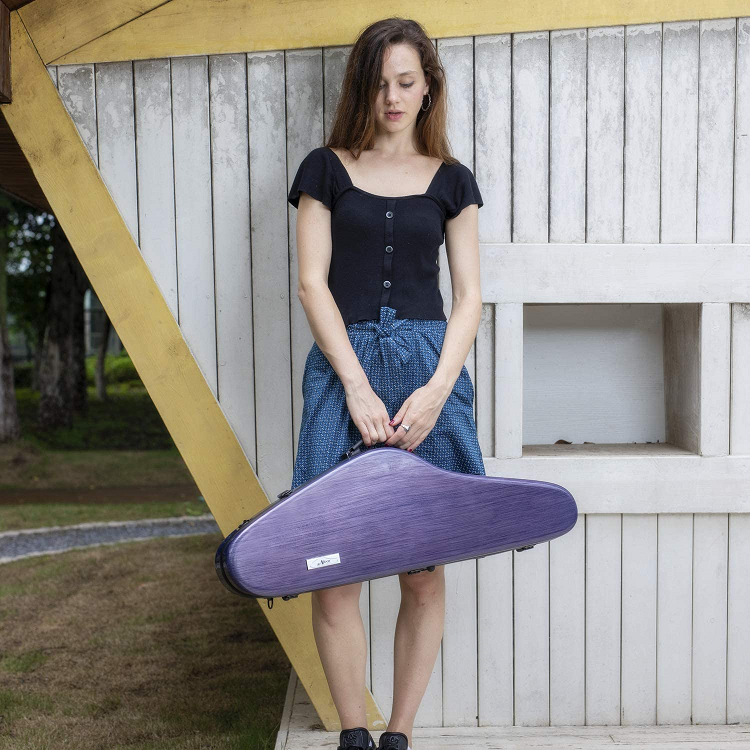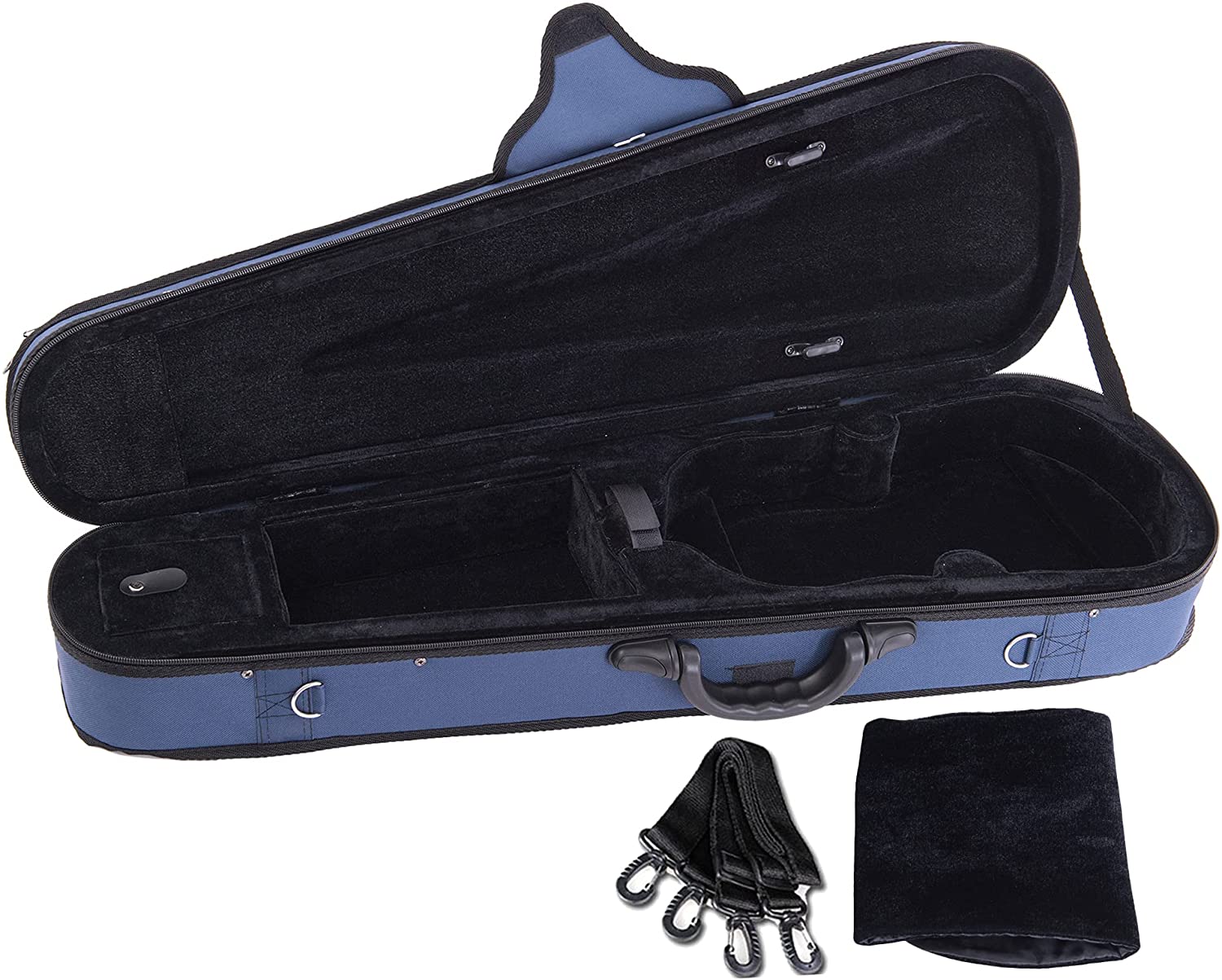- How to Find the Best 5 String Violins - April 19, 2022
- Top Violin Accessories to Consider - April 18, 2022
- Best Left-Handed Violins Guide - April 13, 2022
Summary: Of the best flute case options today, your decision comes down to the hard or soft case and a series of characteristics inside and out.
There are many accessories you need for a violin. It would be best if you had a cleaning cloth, rosin, a good violin bow, and most importantly, a case in which to put all of that. But how do you find the proper case when so many different materials are on the market? This best violin cases guide is here to help.
Bottom Line Up Front: I recommend the Aileen 4/4 Full-Size Luxury for its lightweight but durable fiberglass design, its use of recycled materials for the construction, and its built-in hygrometer.
I have evaluated the options in this best violin cases guide based on the material used in their construction, how much they cost, and whether they have spaces for accessories inside.
Who Needs a Violin Case?
Any musician with a violin should consider finding a violin case. This best violin cases guide makes finding something suitable for your needs easy.
For example:
- If you have a child who is just starting their musical experience, you should invest in a beginner hard case so that they can protect their instrument when they are carting it to and from music lessons.
- If you have a teenager who performs at school, they need to protect their violin when they lug it around campus, in between classes, when they leave it in the band room, or when they take it to and from performances.
- If you are a violinist and perform now and again, whatever level of instruments you are working with is an investment that needs to be protected. Even if you work with a group of reputable musicians, accidents still happen, and one of the best ways to prevent them from happening is to have a hard case in which to store your violin when you aren’t playing.
Best Violin Cases Guide: What Features Matter Most
I often butt heads with my better half because I’m a very frugal person. I am the person who always visits a dollar store first, and if I can’t find what I need there, moves up to an equally cheap chain store like Walmart or Amazon.
Spending money seems to go against every aspect of my upbringing, so when I look at different accessories for an instrument, I have to be mindful of my immediate gut reaction. The price tag always causes a very visceral “no!” to rise in my mind. So, I have to remove my emotions and think strategically about the investment aspect of spending money.
This is a trait I am still learning today.
Over the years, I have learned to appreciate why certain things cost as much as they do and to evaluate the situations in which that extra cost is worth it.
Materials: Soft vs Hard
I assure you that one of the critical areas where the extra cost is worth the investment if you can afford it is the material used for your violin case.
It is easier to look at a soft case price tag and decide it’s the best option because it’s the cheapest. You will find two categories of materials:
- Soft cases
- Hard cases
Soft cases are cheaper because they are soft, so the material is pliable and gives you something to hold your violin and accessories. It might keep it a little dryer in the rain compared to having it under your jacket. Still, it won’t protect your instrument from getting stepped on, crushed, or dented in serious accidents.
Who Should Use Soft Cases
Soft cases are better for storage in the house, people who don’t want to deal with a heavy or expensive case, and individuals who only take their instrument to and from things like music lessons or Church events.
Hard cases are not liable, so they have an exterior shell that won’t give if you drop your case, smash it into something, or have any other accident. A hard case is also heavier because of the material from which it is made.
Who Should Use Hard Cases
Hard cases are better for people who travel to and from their concerts, regularly fly or sail, or want additional protection around the house.
I, for example, have multiple pets and children who like to run around even when they aren’t supposed to. Some of those pets are cats who want to climb where they shouldn’t and knock things over. It’s not worth the risk of having a soft case when I know someone will knock it down eventually.
This video explains how to use a violin case and put your instrument safely inside:
What Size is Best?
When you pick a violin case, you need to make sure it’s the appropriate size for the type of violin you have. Violins are broken down into fractional sizes. Children might have toy violins 1/16 in size, while most teenagers and adults have ¾ or 4/4 lengths.
It is essential to verify that the case size is suitable for your instrument; if the case is too small, your violin won’t fit, and if it’s too big, your violin will have too much room to move around so it won’t reap the benefits of the protection.
Characteristics for Violin Cases
When evaluating an instrument case, especially for a violin, you have to consider the interior and exterior characteristics. You primarily have to decide between a soft or hard desig for the exteriorn. You also have to look at weatherproofing and how tight the seal is when the case is locked. Exterior components extend to the hardware.
Strong metal hardware will be most effective at ensuring your violin case doesn’t accidentally open when you don’t want it to. If you live in a place prone to rain, like Seattle, consider investing in a case that has exterior waterproofing and a humidity detector on the inside.
As far as interior components are concerned, you mostly want to look for the lining it has. More expensive models will have suspension, which means it’s foam on the inside into which your violin rests perfectly fitted.
This creates a sort of suspension where your violin never rests against the perimeter of the case, so it’s protected against any impact. You also need to be aware of any storage pockets you want for things like rosin, spare bows, extra strings, etc.
Selection Criteria
As I reviewed different products for this best violin cases guide, I broke down my viewpoint and recommendations based on the material used in construction, how durable it was, and the price.
As a parent, I am a firm believer in finding something that is durable and suitable to your budget. If you have a child learning to play the violin, you don’t need a high-end carbon fiber hard case, but you can still find a suitable hard case.
Best Violin Cases Guide
So, let’s look at my top selections for students, intermediate players, and professionals.
Gewa Pure
For professionals or anyone who wants the ultimate protection, the German-made Gewa Pure is the way to go. It is constructed from polycarbonate, one of the most robust plastic materials used in the construction of shatterproof glass.
Most people think carbon fiber is one of the most powerful materials for violin cases but carbon fiber sheets up under direct sunlight while the polycarbonate shell does not. You can choose an oblong shape or a contoured shape. It has a detachable accessory pouch, so you can take it out if you need to and carry it separately.
All of the hardware is strong metal lashes and locks. There is a padded suspension system inside. It has a sturdy main handle, side handle, removable music pocket, and two detachable backpack straps, depending on how you want to carry it.
Pros
- It comes in contoured or oblong shapes
- Scratch-resistant
- Polycarbonate shells
- Removable accessory pouch
- Only 4-5 pounds
Cons
- Expensive and meant for professionals
Aileen 4/4 Full-Size Luxury
The Aileen 4/4 Full-Size Luxury is similar to the Gewa Pure in its construction, but it is made with fiberglass. The fiberglass is strong but lightweight. A full-size violin hard case only weighs 5 lb. It comes with space to hold two bows, your shoulder rest, and a separate compartment for accessories. I love that it has a built-in hygrometer to check for moisture.
The fiberglass exterior is constructed from recyclable material, which means it’s a more environmentally friendly design. It has sturdy metal hardware and latches to keep the case closed. There are three metal D rings and adjustable straps, so you can use the regular handle, sling it over your shoulder, or wear it like a backpack.
Pros
- Metal latches
- Three ways to carry it
- Weighs five pounds
- Built-in Hygrometer
- Fiberglass construction
Cons
- It comes in light purple or white
ADM 4/4 Full-Size Violin Hard Case Basic
The ADM 4/4 Full-Size Violin Hard Case Basic is one of the most common violin cases in schools or music rental shops. It is meant for beginners, and it serves its purpose quite well. It doesn’t have a contoured form, but it has a nylon raincoat fabric cover on the exterior. This makes it moderately waterproof.
Inside are suspension cushions and a velcro neck holder. It also has a blanket over the violins, so your children don’t accidentally scratch the top of the violin when they put something else in the compartment. It comes with a small accessory pouch that can hold beginner rosin, a cleaning cloth, and two spaces for bows.
It is very lightweight, only 2.5 lb, and has two options to carry it either by hand or with the straps worn like a backpack. The zippers are the most significant point of failure. Instead of metal hardware or latches, a zipper goes all the way around the case. This model costs half as much as the other hard case options, making it the most common beginner violin case for students.
Pros
- Perfect for students
- Interior suspension
- Easy to carry
- Lots of storage inside
- It weighs only 2.5 pounds
Cons
- A remedial design only intended for students and beginners
FAQs
Answer: Polycarbonate is one of the strongest plastic materials used to produce shatterproof glass. It is a temperature-resistant, protective hardshell option you can use for a violin.
Polycarbonate is slightly more protective than the more commonly used carbon fiber case, suitable for professionals. Of course, if you have a beginner in your family or you like to play for fun, you don’t necessarily need the most protective material.
Answer: Professionals invest in high-quality material. Of the best violin cases on the market, professionals will pick polycarbonate or carbon fiber designs.
Professionals invest in the pinnacle of options included in this best violin cases guide because their instruments are more expensive and, as such, need extra care. Professionals also need violin cases that can withstand a broader range of transportation, such as in the cargo bay under a plane.
Answer: How much you spend on a violin case is based on your budget and needs. If you have a beginner in your family, a young child just learning to play the violin, you can invest in any simple hard case for less than $100. You don’t have to invest in professional polycarbonate cases that cost a few thousand dollars.
Answer: Violin cases designed for more professional players have hygrometers so that you can verify how much moisture is in the air. There are two types: dial-type mechanical hydrometers or digital electronic hygrometers. Hygrometers can help you verify if the air is too humid. This is something important for professionals who have gut strings.
Gut strings, just like your gut lining, naturally absorb moisture. If the air is too humid inside your violin case, the gut strings absorb all of the excess water. Then the gut strings don’t hold their tautness, and they go out of key, so you have to retune them.
Bottomline
I recommend the Aileen 4/4 Full-Size Luxury as my top pick. It is worth the extra investment for any musician. It comes in different sizes to find one for a ¾ or 4/4 violin. I particularly love that it only weighs 5 lb which is one of the lightest cases in this best violin cases guide.
It has a built-in hygrometer with storage space for your accessories, multiple ways to carry it, and high-quality latches and hardware. No matter which violin case you choose, make sure it fits your instrument.
Invest in a hard case if you can; otherwise, your delicate violin has a severe chance of damage. No matter which you choose from this best violin cases guide, you can find something to match your musical skill, instrument, and budget.
Looking for more interesting readings? Check out:

